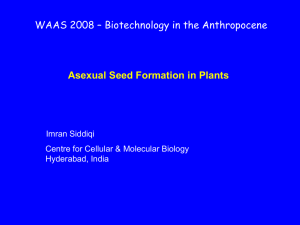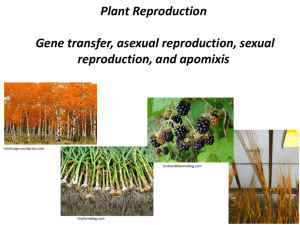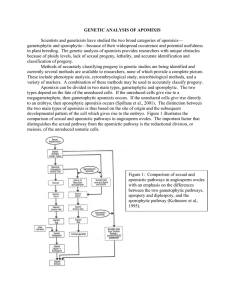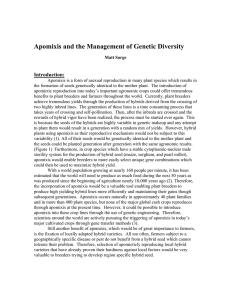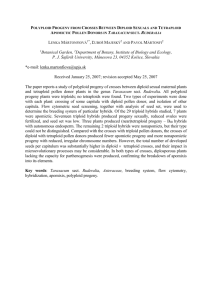Genetic Analysis of Apomixis
advertisement
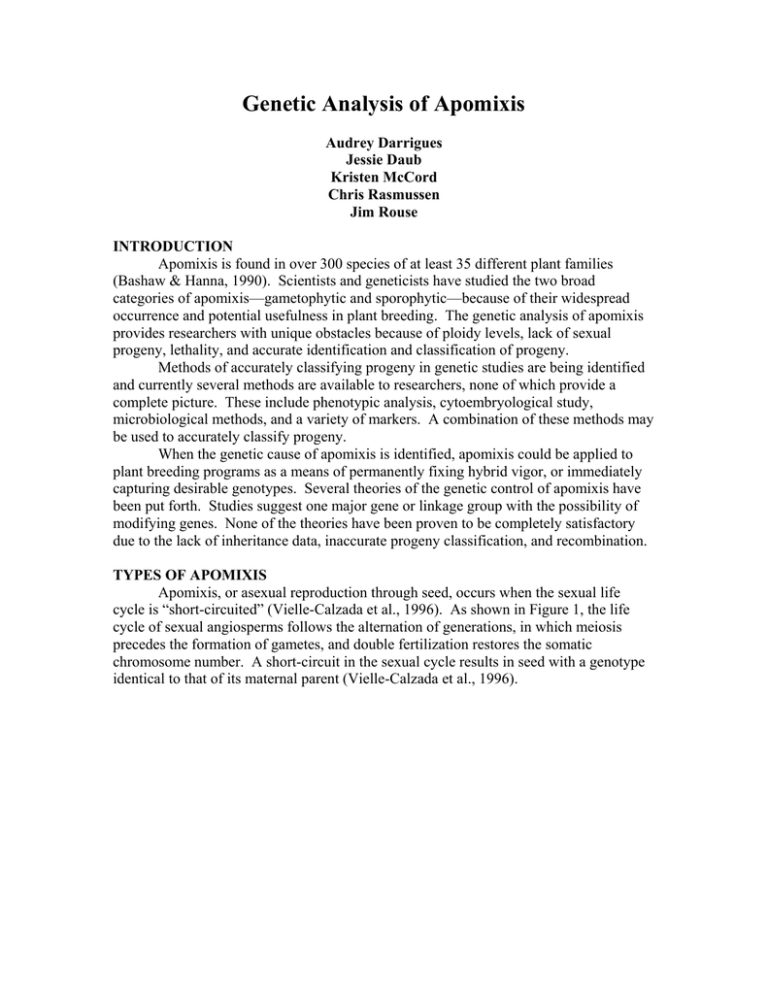
Genetic Analysis of Apomixis Audrey Darrigues Jessie Daub Kristen McCord Chris Rasmussen Jim Rouse INTRODUCTION Apomixis is found in over 300 species of at least 35 different plant families (Bashaw & Hanna, 1990). Scientists and geneticists have studied the two broad categories of apomixis—gametophytic and sporophytic—because of their widespread occurrence and potential usefulness in plant breeding. The genetic analysis of apomixis provides researchers with unique obstacles because of ploidy levels, lack of sexual progeny, lethality, and accurate identification and classification of progeny. Methods of accurately classifying progeny in genetic studies are being identified and currently several methods are available to researchers, none of which provide a complete picture. These include phenotypic analysis, cytoembryological study, microbiological methods, and a variety of markers. A combination of these methods may be used to accurately classify progeny. When the genetic cause of apomixis is identified, apomixis could be applied to plant breeding programs as a means of permanently fixing hybrid vigor, or immediately capturing desirable genotypes. Several theories of the genetic control of apomixis have been put forth. Studies suggest one major gene or linkage group with the possibility of modifying genes. None of the theories have been proven to be completely satisfactory due to the lack of inheritance data, inaccurate progeny classification, and recombination. TYPES OF APOMIXIS Apomixis, or asexual reproduction through seed, occurs when the sexual life cycle is “short-circuited” (Vielle-Calzada et al., 1996). As shown in Figure 1, the life cycle of sexual angiosperms follows the alternation of generations, in which meiosis precedes the formation of gametes, and double fertilization restores the somatic chromosome number. A short-circuit in the sexual cycle results in seed with a genotype identical to that of its maternal parent (Vielle-Calzada et al., 1996). Apomixis- Genetic Analysis 2 Figure 1: Sex or apomixis? The sexual life cyle of flowering plants and the apomictic reproduction by seed which occurs when the sexual life cycle is shortcircuited (Vielle-Calzada et al., 1995). Apomixis can be divided in two main types, gametophytic and sporophytic. The two types depend on the fate of the unreduced cells. If the unreduced cells give rise to a megagametophyte, then gametophytic apomixis occurs. If the unreduced cells give rise directly to an embryo, then sporophytic apomixis occurs (Spillane et al., 2001). The distinction between the two main types of apomixis is thus based on the site of origin and the subsequent developmental pattern of the cell which gives rise to the embryo. Figure 2 illustrates the comparison of sexual and apomictic pathways in angiosperm ovules. The important factor that distinguishes the sexual pathway from the apomictic pathway is the reductional division, or meiosis, of the unreduced somatic cells. Sporophytic apomixis, also referred to as adventitious embryony, is a process in which the embryo arises directly from the nucellus or the integument of the ovule (Koltunow et al., 1995). The embryo development is initiated as a bud-like structure through mitotic division of the cell nucleus (Bashaw, 1980). The formation of the embryo sac is normal. Because it occurs normally, the embryo sac formation is not involved with apomixis. Sporophytic apomixis occurs commonly in Citrus species but rarely in higher plants. As such, there is much less information available regarding sporophytic versus gametophytic apomixis. Apomixis- Genetic Analysis 3 Figure 2: Comparison of sexual and apomictic pathways in angiosperm ovules, with an emphasis on the differences between the two gametophytic pathways, apospory and diplospory, and the sporophytic pathway (Koltunow et al., 1995). In the more common gametophytic apomixis, two mechanisms are generally recognized, diplospory and apospory. The two mechanisms are distinguished by the origin of the cells that give rise to the apomictic embryo. In diplospory, the embryo sac originates from the megaspore mother cell either directly by mitosis and/or after interrupted meiosis. In both cases, an eight nucleate embryo sac is formed. In mitotic diplospory, the megaspore mother cell does not undergo meiosis. The megaspore mother cell itself undergoes three mitoses to develop an embryo sac of eight nuclei. In the event of meiotic diplospory, one of the megaspores that constitute the dyad (rather than the linear tetrad of megaspores in sexual life cycle) degenerates. After three mitoses, an embryo sac of eight nuclei results as usual, except that it is unreduced both in chromosome number and in genetic content relative to the parental sporophyte. In apospory, the embryo sac originates from nucellar cells. Apospory is the most common mechanism of apomixis in higher plants. Occasionally, it can be characterized by the presence of multiple embryo sacs (Bashaw, 1980). Apomixis- Genetic Analysis 4 METHODS TO IDENTIFY APOMICTS To identify plants used in the genetic analysis of apomictic species, researchers use phenotypic methods, cytoembryological characterization, genetic markers, biological tests, and whole plant testing (using a combination of methods) to determine the location of the gene(s) controlling apomixis in a viable crop species. These methods enable the classification of aberrant progeny derived from the cross of an asexual by sexual plant to precisely determine the mode of reproduction followed by each plant. Using these methods in addition to embryo sac cytology and progeny testing, plant scientists are starting to realize the nature and usefulness of introgressing the apomictic gene into sexual plant species important in modern agricultural cropping systems. Phenotypic Identification Phenotypic detection of apomixis involves the classification of a known heterozygous maternal parent and its progeny (grown from seed) with no observed segregation; or, in the case of facultative apomicts, the presence of several progeny with complete heterozygosity (that is, no known traits homozygous that were heterozygous in the maternal parent). Phenotypic classification may involve the least work of any technique for detection of apomixis, but is also the least reliable. Codominant or incompletely dominant alleles are necessary for proper classification of heterozygotes. Other factors, such as interference with meiotic crossing over, may make progeny appear to reproduce the maternal genotype when in fact they do not. The analysis of traits that cannot be classified visually (enzyme activity, starch production, etc.) may provide enough additional phenotypic information to greatly improve accuracy (Khokhlov, 1970). In the absence of pseudogamy, careful emasculation and isolation of the maternal parent may also provide evidence of apomixis. In this case, if fertile seeds are produced in the absence of pollen, apomixis is likely present. In addition, the production of a high percentage of irregular, sterile pollen grains is a traditional, reliable apomixis indicator, but for autogamous plants only (Asker and Jerling 1992). Cytoembryological Detection Cytoembryological detection involves the observation of the developing spores and embryo to see whether reduction of genetic material occurs and to observe the nature of chromosome segregation in the formation of the megaspore, and to rule out the possibility of gametic fusion. This can be quite laborious, but does enable the detection and classification of the form of apomixis. These may include reduced forms: parthenogenesis, pseudogamy, androgenesis, or synergid apogamy; or unreduced forms: semigamy, pseudogamy, parthenogenesis, synergid apogamy, or antipodal apogamy. Meiosis leading to the development of each of these forms may proceed in several different ways. All reduced forms begin with normal meiosis, while the unreduced forms may begin with apohomotypic, semiheterotypic, pseudohomotypic, or mitotic divisions in place of all or part of normal meiosis. These are observed by plating and staining of the relevant cells in various stages and determination of ploidy level for both megaspore mother cell (or megaspore) and for the surrounding tissues (Khokhlov, 1970). Apomixis- Genetic Analysis 5 Microbiological Methods In the examination of apomixis, biological methods such as the auxin test, cytological tests, and ovule culture tests have proven useful in showing the characteristics of apomictic plant species. The auxin test can be used to demonstrate the estimation of the frequency of apomixis in Kentucky bluegrass (a facultative apomictic crop) (Sherwood, 2001). The auxin test “estimates the asexual potential of Kentucky bluegrass as the frequency of auxin-induced, endospermless grains combining one or more parthenogenic embryos,” (Mazzucato et al., 1996). The test uses a synthetic auxin placed on the inflorescence before anthesis, which induces parthenogenic apomixis. These individual plants will develop grains that form mature embryos but no endosperm, whereas the opposite occurs for nonparthenogenic plants. The difference in the frequency between the two progeny plant types developed by the auxin test allows the estimation of apomictic capacity of the selected parents. “The auxin test provides a rapid, simple and precise method of estimating the frequency of parthenogenesis among aberrant progeny” (Mazzucato et al., 1996). Molecular and Conventional Markers The idea of using molecular markers in genetic studies of apomixis has been forwarded by the increased understanding of both sporophytic and gametophytic apomictic plant systems. Also, “most if not all apomicts are facultative, where both apomictic and sexual reproduction occur to differing extents in the same plant,” (Spillane et al., 2001). The use of conventional and molecular markers in examining apomixis in plant research has followed three main approaches. The first of these approaches is mapping and gene discovery to identify loci controlling apomixis in apomictic plants (Spillane et al., 2001). Molecular markers, such as RFLPs, RAPDs, and AFLPs are screened onto segregating apomictic populations and their respective parents through different mapping strategies (i.e. bulk segregant analysis, selective mapping, and comparative mapping) to detect any polymorphism that may be present. If polymorphism arises more markers are screened into the area and linkage analysis is done to determine if linkage groups are present and to help create a map of the specific genomic region associated with apomixis. The problem with this technique, however, is that there are few traits specifically linked to apomixis that can be used as markers. Sherwood (2001) states that, “apomictic genes have no known effects on plant characteristics.” Until recently, this imposed a barrier in mapping apomictic species because a large number of markers were not available to provide linkage analysis information to map the apomictic gene region. Apomictic mapping and identification of the region containing the apomictic gene was done in the South American grassland species of Brachiaria decumbens segregating for reproductive mode among its progeny. However, genetic mapping of the Brachiaria was the first step of the identification process. In the mapping process, “the F1 family of Brachiaria segregating for reproductive mode was assayed using the bulk segregant analysis approach and a set of maize clones which spanned the maize genome,” (Haywood, 1999). The researchers mapped the clones to maize chromosome 5, with the use of AFLPs, which led to ten other markers being identified close to the apo-locus region. The markers were then plotted and “a genetic map of the Brachiaria genome was Apomixis- Genetic Analysis 6 constructed with the closest markers at a distance of 1 and 5 cM from either side of the apo-locus,” (Haywood, 1999). A second strategy involving the use of molecular markers is using well characterized sexual model systems such as Pennisetum glaucum and Zea mays to identify genes which, if mutated or deregulated, result in phenotypes resembling elements of an apomictic pathway (Spillane et al., 2001). To display how molecular markers work within this system, the introduction of apomixis into the sexual P. glaucum (pearl millet) was examined. The apomictic genes in the wild plant species P. squamulatum have been successfully transferred over into the cultivated pearl millet species P. glaucum following three generations of backcrossing between the two plant species. Ozias-Askins et al. (1992) identified molecular markers, RAPDs and RFLPs, which demonstrated the presence of apomictic P. squamulatum DNA. This was determined by using BC3 lines plus four other cultivars present in the original pedigree and “applying two different types of molecular markers dependent on DNA sequencing or arrangement in linkage studies,” (Ozias-Askins et al., 1992). The procedure consisted of taking BC3 plant material, extracting the DNA and hybridizing it, followed by DNA sequencing and amplification. The results showed that 94% of the markers used were polymorphic between P. glaucum and P. squamulatum leading to isolation of the apomictic genome region. Ozias-Askins et al. (1992) concluded at least two independently assorting linkage groups in the BC3 derived from apomictic P. squamulatum. Caution should be used in the interpretation since there was not enough information given on fragment deletions, rearrangement of chromosomes between the markers surveyed, and the apomictic gene itself. “Pennisetum has been chosen as a model system because strong expression of the apomictic trait persists in hybrids, and genetic material suitable for molecular studies involving molecular markers (RAPDs and RFLPs) was available,” (Ozias-Askins et al., 1992). Later studies by Lubber and Ozias-Askins showed that the previously described RAPD (CO4600) marker was associated with 3 of the 11 apomictic species, P. cilliare, P. massican, and P. squamulatum. The RFLP (UGT197) marker was also closely linked to the apomictic marker gene CO4600 and other genes associated with the apomictic gene. Overall, “the successful use of these probes to survey other Pennisetum species indicates that apomixis is a trait that can be followed across species by molecular means,” (Lubber et al., 1994). The group also showed that the concept of examining species within a genus might lead to identifying other markers and the gene(s) that control apomixis. Conventional markers can be used for the analysis of progeny after a hybridization event between a cross of a facultative asexual species and sexual species. The use of markers is essential since three different sexual ‘off-types’ are frequently observed in the progeny of apomicts: (1) BIII hybrids, (2) BII hybrids and (3) polyhaploids, (Spillane et al., 2001). Conventional, unlinked, monogenically inherited traits have been used as markers to distinguish maternal (asexual plants) from sexual (sexual off-type) plants (Sherwood, 2001). Sherwood (2001) gives a situation where conventional markers are useful “if the asexual female parent is homozygous for a recessive trait and the pollen parent is homozygous dominant, uniformity of the progeny for the asexual female parent marker would suggest maternal inheritance.” Therefore, the use of traits as homozygous or heterozygous markers has allowed the identification of aberrant progeny from the asexual female by sexual male parent species crosses. Apomixis- Genetic Analysis 7 Combined Use of Methods An example of using a combination of more than one method of identifying the apomictic characteristics of a plant is illustrated in the plant species Poa pratensis (Kentucky bluegrass). To differentiate between aberrant progeny in cross-fertilized species of Kentucky bluegrass, flow cytometry and silver stained RAPD (ssRAPD) markers were utilized to help determine ploidy level and progeny mode of reproduction. The cross-fertilized hybrid between a “Mystic” (maternal) cultivar and an “America” (paternal) cultivar was used to develop aberrant progeny for analysis. After running flow cytometry and screening ssRAPD markers on the progeny, the results showed the existence of both sexual and asexual progeny. The study shows, “flow cytometry determination of nuclear 2C DNA content and ssRAPD markers to be highly repeatable, accurate, and easy to perform in distinguishing the genetic origin of aberrant progeny in large apomictic populations,” (Huff and Bara, 1993). GENETIC BASIS FOR APOMIXIS Scientists for over a century have recognized that apomixis is transmitted from parent to progeny. Even Gregor Mendel attempted early genetic analyses of crossings between sexual mother plants and apomicts in the 1800s (Nogler, 1984a). A lack of inheritance data needed for critical genetic analysis has posed problems in understanding apomixis. Theories of inheritance with apomicts have evolved over time. Early theories were dominated with ideas of polyploidy and hybridity. To reach these conclusions, researchers studied the nature and behavior of apomicts and noted most apomictic plants were polyploid and cytologically resemble species hybrids. Physiological factors and hormones were thought to be direct causes of apomixis. For example, one theory proposed wound hormones produced when plants were injured induced apomixis. Stebbins (1941) ruled out polyploidy as a cause of apomixis because sexual polyploids greatly outnumber the apomicts. Gustafsson in 1947 analyzed evidence for each theory of the time and concluded that no single phenomenon could be responsible (Bashaw & Hanna, 1990). Spillane et al. (2001) separates apomixis into three major elements required for viable seed set. These are: (1) the absence of alteration of meiosis preventing reduction (apomeiosis), (2) the activation of the egg cell to form an embryo in the absence of fertilization (parthenogenesis), and (3) the initiation of endosperm development either autonomously or pseudogamously. Due to the complexity of the apomictic system and the lack of inheritance data, it has been difficult to develop a single genetic explanation for apomixis. Several theories are currently being debated and can be divided into theories regarding apospory and diplospory. Apospory Apospory, as discussed earlier, is the development of an unreduced embryo sac from somatic cells. Current theories on the genetic cause of apospory can be divided into either a two gene or a single gene system. Studies on the Panicoidea indicated that one locus controlled apospory and a second independent locus affected sexuality. Burton & Forbes in 1960 demonstrated Apomixis- Genetic Analysis 8 genetic control of apospory in Paspalum notatum using a novel hybridization technique. All tetraploid bahiagrass is obligate aposporous apomicts. To obtain sexual tetraploids for study, the chromosome number of a diploid strain (Pensacola bahiagrass) was doubled to produce a sexual autotetraploid. Crossing this sexual tetraploid with apomictic tetraploids produced progeny either obligately apomictic or completely sexual. The analysis of these data indicated that a few recessive genes controlled apomixis (Bashaw & Hanna, 1990). Hanna et al. (1973) used naturally occurring sexual tetraploids from plant introductions as female parents in crosses with tetraploid apomicts. The results indicated that sexuality was dominant to apomixis 11:5 and that the method of reproduction was controlled by two loci acting in an additive fashion. The paper gives no detail on the resoning of why the loci were acting in an additive fashion. Taliaferro & Bashaw (1966) investigated the inheritance of apomixis in buffelgrass. The resulting data indicated a mode of reproduction controlled by two genes with epistasis favoring dominant expression of the gene for sexuality. The A gene was hypothesized to control all processes that result in unreduced nucellar embryo sacs and abortion of normal sexual sporogenous tissue. The B gene would then be epistatic to A nullifying all action of the gene and restoring sexuality. The conclusion was plants with B_ or aabb would sexually reproduce. Sherwood et al. (1994) tested seven models of genetic inheritance and proposed an alternative analysis to the three previously mentioned studies. This was one genetic model involving two tetrasomically inherited loci. In this model the A locus is a dominant gene for apomixis and recessively lethal. The B locus has a dominant allele epistatic to A. The authors hypothesized that in previous studies, the sexual parents were actually facultative aposporous plants Aaaa with a high degreee of sexual expression due to modifying genes. Nogler (1984a) suggests a monogenic inheritance for apospory where the induction of aposporous embryo sac from somatic nucellar cells is possible by an apospory factor A-. The wild allele A+ does not contribute to apospory but may function in the normal sexual life cycle. Nogler (1984a) noted that plants homozygous for A- were unknown, suggesting lethality. Sherwood et al. (1994) offered a reinterpretation of Nogler (1984a) study. The authors agree that the data fits a monogenic inheritance pattern if there is random chromatid assortment. However, if there is random chromosome assortment than the picture of inheritance is unclear. Savidan in 1991 and 1992 and Peacock in 1993 suggest a single master gene responsible for the induction of embryo sac formation (Sherwood, 2001). Induction would trigger events requiring direction by many genes and having a potential for modifying genes. Perhaps several genes relating to apomixis may be on a small chromosome segment or linkat. Jefferson in 1993 suggested apomixis involves phenotypic mutations at several loci acting together as a nonrecombining unit (Sherwood, 2001). This would give rise to the apomeiosis locus discussed by Spillane et al. (2001). As mentioned earlier, Spillane et al. (2001) divide apomixis into three sections: (1) apomeiosis, (2) parthenogenesis, and (3) endosperm development. The authors propose that the inheritance of each section should be studied independent of the others and the data combined for the overall “picture.” A single Mendilian factor was found to Apomixis- Genetic Analysis 9 control apomeiosis. However, the apomeiosis loci is located in a region of the chromosome where recombination is suppressed making map based cloning difficult. It is not understood if this suppression is due to the apomeiosis loci or a manifestation of the apomeiosis loci. The molecular mechanism regulating parthenogenesis is unknown. The authors found that the parthenogenesis locus is linked to apomeiosis loci in some but not all species. Functional endosperm development segregated independent of the apomeiosis loci and the parthenogenesis locus. The authors concluded that apomixis is controlled by more than one gene, which may or may not be linked. Diplospory Diplospory is the second type of gametophytic apomixis. Diplospory differs from apospory in the origin of the unreduced embryo sac. Recall that in apospory, the unreduced embryo sac originates from a somatic cell of the ovule. The diplosporic embyro sac arises from a generative cell, either directly by mitosis, or indirectly by modified meiosis, resulting in an unreduced restitution nucleus. Mitotic diplospory is the more common type, also called the Antennaria type of diplospory. Less common is the restitutional diplospory, also known as Taraxacum type. Characterization of diplospory is much more difficult than apospory on the basis of cytological evidence (Bashaw & Hanna, 1990). In mature ovules characterization is nearly impossible, as the embryo sac may appear completely normal. Cytological evidence of diplospory requires examination of early megasporogenesis, when normal meiosis would be expected. If mitotic metaphase is observed instead of meiosis in the megaspore mother cell, this indicates diplospory. Further evidence would be the absence of the linear tetrad of megaspores, absence of the premegaspore dyad, and the position of the embryo sac at the two- to four-nucleate stage (Bashaw & Hanna, 1990). Most reports on the inheritance of diplosporic apomixis were hindered by the lack of suitable sexual parents and the difficulties with cytological classification. However, there have been a few conclusions drawn from a handful of studies. Mitotic diplospory In Eragrostis curvula (weeping lovegrass, Poaceae), Voigt and Burson (1983) crossed naturally occurring sexual tetraploids with apomictic tetraploids and hexaploids. The F1 progeny test segregations indicated that apomixis was a single gene dominant trait. Sherman et al. (1991) studied apomixis in Tripsacum dactyloides (Eastern gamagrass, Poaceae). The authors crossed a sexual diploid female with a triploid apomict and examined the offspring. They identified 46 hyperdiploid progeny as hybrids, and all but two showed some cytological evidence of apomixis, and to varying degrees. The authors believed this to indicate an incompletely dominant pattern of inheritance, or that minor additive genes affected the penetrance of apomixis. Leblanc et al. (1995) found the T. dactyloides tetraploid is simplex for the diplospory allele, based on the 1:1 segregation of maize-Tripsacum F1s for mode of reproduction. Working with Parthenium argentatum (guayule, Asteraceae), Gerstel and Mishance (1950) made reciprocal crosses between a sexual diploid and a facultatively diplosporous hyperdiploid. The results were less than conclusive. With the sexual plant as the maternal parent, all the progeny were sexual. In the reciprocal, most progeny were Apomixis- Genetic Analysis 10 maternal (polyploid apomictics), but there were a few diploid sexual F1s. Gerstel and Mishance hypothesized a recessive but additive apomixis gene model. In addition, they concluded that polyploids with two apomixis genomes and one sexual genome were apomictic. The results of this test were interpreted differently by others. The experiment (starting materials and results) was similar to one performed by Nogler (1984b) on Ranunculus. Nogler theorized a single dominant gene controlling apomixis, but acting as a recessive lethal. The polyhaploid parents would then be Aaa, and the diploids aa. Restitutional diplospory Theories regarding restitutional diplospory involve studies of Taraxacum (dandelion, Asteraceae). According to Sherman (2001), eutriploids (2n = 24) and many hypotriploids (2n=23) have facultative diplospory. Certain hypotriploid aberrants are primarily sexual (Sorensen, 1958 in Sherman, 2001). Interpretation of studies involving these types of plants has led to a more complicated hypothesis of the inheritance of apomixis. Mogie (1988) proposed that apomictic expression depended on one or more genes on one chromosome, and on dosage. Two copies of the mutant apomixis allele would be required to cause apomixis. In diplosporous apomicts, the allele would prevent meiosis. The relationship of the dominance between the wild type and mutant allele would vary depending on the environment. Mogie further suggested that the wild type (a) allele of the apomixis locus would have an essential function in the plant, perhaps coding for meiotic reduction and being involved in control of mitosis. This mitotic control would be disrupted by the expression of the mutant allele in somatic cells. CONCLUSION Molecular markers, biological tests, cytoembryological studies, phenotypic analysis, and combinations of these techniques have increased the ability to accurately identify and characterize the gene(s) controlling apomictic expression in apomictic plant species. The use of molecular markers such as RFLPs, RAPDs, and AFLPs enabled Ozias-Askins et al. (1992) to identify the apomictic genome region regulating apomixis after backcrossing the apomictic P. squamulatum species into the sexual cultivated crop species of pearl millet (P. glaucum). Also, biological testing methods, such as the use of the auxin test, allows accurate evaluation of aberrant progeny from a cross between asexual female and sexual male parents by determining the frequency of parthenogenic embryos. Finally, combined use of two or more of these approaches during genetic analysis of apomicts allows more precise results of apomictic gene(s) location and differentiation between progeny to be obtained. Modern molecular genetics are being used as a tool to identify genes and physiological or biochemical pathways responsible for changing the role of specific cells giving rise to apomictic cells. Currently, apomeiosis loci have been identified. However, recombination around these loci is suppressed, making map based cloning difficult. The degrees of complexity of these loci are unknown. Although the mechanisms of apomictic inheritance have been studied in relatively few species, there are several proposed models for its genetic control. Theories of inheritance range from a single apomixis locus or linkage group common to all apomicts to independent, random mutations at various reproductive loci. The truth about Apomixis- Genetic Analysis 11 inheritance of apomixis appears to lie somewhere between these two extremes. Whatever the underlying mechanism, the genes that are affected by these loci are likely to play important roles in sexual development and understanding of apomixis (Spillane et al., 2001). GLOSSARY androgenesis A haploid embryo develops from the haploid sperm nucleus. apogamy Development of sporophyte directly from gametophyte, without fusion of gametes; such sporophytes have the same chromosome number as the gametophyte from which they have been derived (cf. apospory, diplospory). parthenogenesis A haploid embryo develops from the haploid egg. pseudogamy Pollination serves as a stimulus for embryo development but the egg and sperm nuclei do not fuse. Fusion of the polar nuclei with one of the sperm nuclei may occur to produce endosperm. semigamy The haploid sperm nucleus enters the egg but does not fuse with the haploid egg nucleus. Each nucleus divides independently creating a haploid embryo that contains sectors of male and female origin. ssRAPD A modified version of the RAPD technique by utilizing silver-stained acrylamide gels rather than ethidium bromide-stained agarose gels. Also uses increased thermocycling ramp times. Apomixis- Genetic Analysis 12 REFERENCES Asker, S. E., and L. Jerling. 1992. Apomixis in Plants. CRC Press, Boca Raton, Florida, USA. Bashaw, E. C. 1980. Apomixis and its application in crop improvement. In W. R. Fehr and H. H. Hadley (eds.), Hybridization of crop plants. Madison, Wisconsin: ASA and CSSA. Pp. 45-63. Bashaw, E. C., and W. W. Hanna. 1990. Reproductive versatility in the grasses. P. Chapman (ed.) Apomictic reproduction. Cambridge U. K. Cambridge University Press. Pp. 100-130. In G. Haywood, M.D. 1999. Manipulation of apomixis for the improvement of tropical forage grasses. http://www.agricta.org/pubs/std/vol2/pdf/242.pdf. Gerstel, D.U., and W. Mishanec. 1950. On the inheritance of apomixis in Partenium argentatum in guayule. Bot. Gaz. 112: 96-106. Hanna, W. W., Powell, J. B., Millot, J. C. and Burton, G. W. 1973. Cytology of obligate sexual plants in Panicum maximum Jacq. and their use in controlled hybrids. Crop Sci. 13: 726-728. Huff, R.D., and J.M. Bara. 1993. Determining genetic origins of aberrant progeny from facultative apomictic Kentucky bluegrass using a combination of flow cytometry and silver-stained RAPD markers. Theor. Appl. Genet. 87: 201-08. Khokhlov, S.S., ed. 1970. Apomixis and Breeding. Nauka Publishers, Moscow. Koltunow, A., R. A. Bicknell and A. M. Chaudhury. 1995. Apomixis: Molecular strategies for the generation of genetically identical seeds without fertilization. Plant Physiol. 108: 1345-1352. Leblanc, O., D. Grimanelli, D. Gonzalez de Leon, and Y. Savidan. 1995. Detection of the apomictic mode of reproduction in maize-Tripsacum hybrids using maize RFLP markers. Theor. Appl. Genet. 90: 1198-1203. Lubbers, E.L., L. Arthur, and W.W. Hanna. 1994. Molecular markers shared by diverse apomictic Pennisetum species. Theor. Appl. Genet. 89: 636-642. Mazzucato, A., A.P.M den Nijs, and M. Falcinelli. 1996. Estimation of parthenogenesis frequency in Kentucky bluegrass with auxin-induced parthenocarpic seeds. Crop Sci. 36: 9-16. Mogie, M. 1988. A model for the evolution and control of generative apomixis. Biol. J. Linn. Soc. 35: 127-53. Apomixis- Genetic Analysis 13 Nogler, G. A. 1984a. Gametophytic apomixis. In B. M. Johri (ed.), Embryology of angiosperms. New York, NY. Springer-Verlag. Pp. 475-510. Nogler, G. A. 1984b. Genetics of apospory in apomictic Ranunculus auricomis: V. Conclusion. Bot. Helvetica 94: 411-22. Ozias-Askins, P., E.L. Lubbers, W.W. Hanna, and J.W. McNay. 1993. Transmission of the apomictic mode of reproduction in Pennisetum: co-inheritance of the trait and molecular markers. Theor. Appl. Genet. 85: 632-638. Sherman, R. A., P. W. Voight, B. L. Burson, and C. L. Dewald. 1991. Apomixis in diploid x triploid Tripsacum dactyloides hybrids. Genome 34: 528-32. Sherwood, R. T. 2001. Genetic analysis of apomixis. In Y. Savidan, J. G. Carman, T. Dresselhaus (eds.), The flowering of apomixis: from mechanisms to genetic engineering. International Maize and Wheat Improvement Center, Mexico. Pp. 65-82. Sherwood, R. T. Berg, C. C. and B. A. Young. 1994. Inheritance of apospory in buffelgrass. Crop Sci. 34: 1490-1494. Sorenson, T. 1958. Sexual chromosome aberrants in triploid apomictic Taraxaca. Botanisk Tidskrift 54: 1-22. Stebbins, G. L. 1940. Apomixis in Angiosperms. Bot. Rev. 7: 507-542. Spillane, C., A. Steimer and U. Grossniklaus. 2001. Apomixis in agriculture: the quest for clonal seeds. Sex Plant Reprod. 14: 179-187. Taliaferro, C. M. and E. C. Bashaw. 1966. Inheritance and control of obligate apomixis in breeding buffelgrass, Pennisetum ciliare. Crop Sci. 6:473-476. Vielle-Calzada, J-P., C. F. Crane and D. M. Stelly. 1996. Apomixis: the asexual revolution. Science 274: 1322-1323. Voight, P. W., and B. L. Burson. 1983. Breeding of apomictic Eragrostis curvula. Proc. 14th Int. Grassl. Congr. Pp. 160-63.
